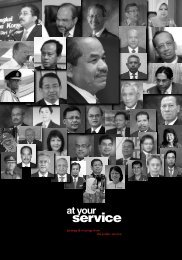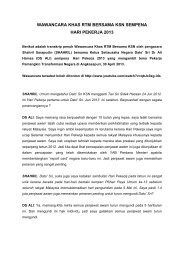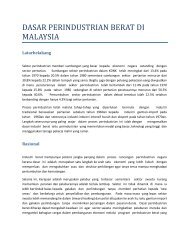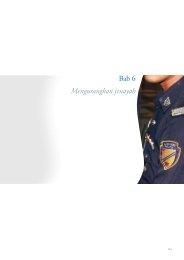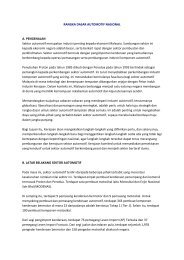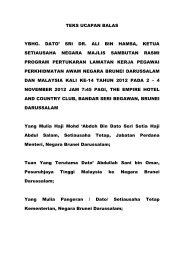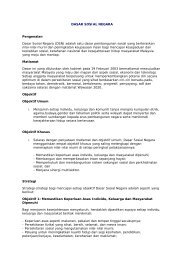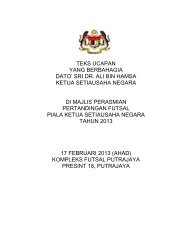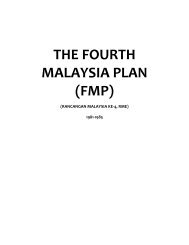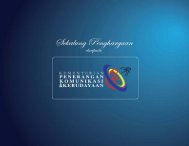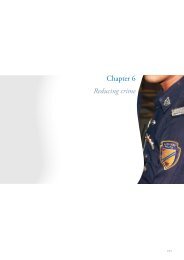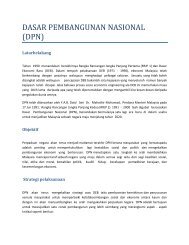GTP 2.0 - Prime Minister's Office of Malaysia
GTP 2.0 - Prime Minister's Office of Malaysia
GTP 2.0 - Prime Minister's Office of Malaysia
Create successful ePaper yourself
Turn your PDF publications into a flip-book with our unique Google optimized e-Paper software.
Over the course <strong>of</strong> <strong>GTP</strong> 1.0, the UPT NKRA<br />
boosted rail KTM Komuter capacity by 144%<br />
to 1,100 riders per train trip from 450 during<br />
peak hours. The team implemented a number <strong>of</strong><br />
quick-win initiatives including adding bigger rail<br />
cars and expanding capacity on busy routes. Rail<br />
presently accounts for about 40% <strong>of</strong> all public<br />
commutes into the city, but was previously<br />
deemed unreliable.<br />
The UPT NKRA has addressed some <strong>of</strong> these<br />
issues, but the majority <strong>of</strong> the work to improve<br />
the rail experience will be implemented in <strong>GTP</strong><br />
<strong>2.0</strong>. KTM track rehabilitation, LRT line extension<br />
and the creation <strong>of</strong> new rail routes also fall<br />
under the purview <strong>of</strong> <strong>GTP</strong> <strong>2.0</strong> as these initiatives<br />
have a longer gestation period than the Big Win<br />
initiatives introduced in <strong>GTP</strong> 1.0.<br />
The UPT NKRA also refurbished a number<br />
<strong>of</strong> bus stations and terminals to create better<br />
service facilities for the rakyat. One notable<br />
upgrade was the landmark Pudu Sentral station,<br />
which was transformed into an inter-urban use<br />
bus terminal. A new terminal, the Integrated<br />
Transport Terminal Bandar Tasik Selatan (ITT<br />
BTS) was also constructed in <strong>GTP</strong> 1.0 and has<br />
commenced operations.<br />
Meanwhile, the UPT NKRA made a number<br />
<strong>of</strong> smaller improvements to road facilities such<br />
as bus stop improvements and to the buses<br />
themselves, all geared towards improving the<br />
commuter experience. Bus ridership increased to<br />
10,000 persons during the peak morning hours<br />
over the first three years <strong>of</strong> the <strong>GTP</strong>. A total <strong>of</strong><br />
1,116 bus stops in Greater KL were refurbished<br />
between 2009 until 2011, whilst a total <strong>of</strong> 272<br />
new bus stops were constructed in 8 Local<br />
Authorities in 2012.<br />
2012 ovERvIEW<br />
The UPT NKRA continued to implement several key initiatives<br />
in 2012, which registered ridership growth that outpaced each<br />
<strong>of</strong> the previous two years: for instance, modal share grew to<br />
20% in 2012 from 16.4% in 2011 and 17% in 2010. Though<br />
the initiatives helped bring up the numbers in 2012, the full<br />
impact <strong>of</strong> the initiatives will not be felt until subsequent years<br />
when there is greater take-up by the rakyat together with<br />
greater service integration.<br />
PUBLIC TRANSPORT MODAL SHARE<br />
20% 20%<br />
19%<br />
18%<br />
17%<br />
16%<br />
15%<br />
14%<br />
17%<br />
16.4%<br />
2010 2011 2012<br />
One <strong>of</strong> the key aspirations <strong>of</strong> the UPT NKRA is to respond to<br />
<strong>Malaysia</strong>n commuters, who have been demanding efficient<br />
public transport. The UPT NKRA has delivered the following<br />
outcomes in 2012, and expects to deliver more in <strong>GTP</strong> <strong>2.0</strong>.<br />
outComE 1<br />
Putting into service six-car sets for the KTM Komuter train service<br />
37 out <strong>of</strong> 38 six-car train sets ordered for the KTM Komuter have been put into service reducing waiting time<br />
during AM peak periods from 45 minutes to 15 minutes. The new six-car sets more than double the capacity<br />
<strong>of</strong> existing rail cars to 1,100 passengers from 450 passengers each. KTM Komuter riders make up 35% <strong>of</strong> all<br />
rail commuters, and rely heavily on the train for their daily commute into the city.<br />
outComE 2<br />
Introduction <strong>of</strong> Go KL<br />
The Go KL is a public bus service <strong>of</strong>fering free rides for commuters within the Kuala Lumpur City Centre.<br />
While the initiative was initially earmarked to be implemented in <strong>GTP</strong> <strong>2.0</strong>, the UPT NKRA introduced two<br />
lines (Green and Purple lines) on August 31, 2012 ahead <strong>of</strong> schedule. Fifteen GoKL buses servicing both<br />
Green and Purple lines report a daily ridership <strong>of</strong> about 14,000 passengers. Indirectly tourists tend to spend<br />
more with free mobility within the shopping district.<br />
outComE 3<br />
Launch <strong>of</strong> Pasar Seni City Bus Hub<br />
The launch <strong>of</strong> the Pasar Seni City Bus Hub in August 2012 greatly enhanced integration between the bus<br />
and rail services in one <strong>of</strong> the busiest areas within the Kuala Lumpur city centre. The RM9.5 million facility is<br />
the first <strong>of</strong> several planned for five main corridors covering the heaviest traffic areas. At the same time, the<br />
Pasar Seni City Bus Hub is also serviced by the GoKL City Bus, a free shuttle service introduced last year as<br />
part <strong>of</strong> the NKRA’s effort to provide seamless connectivity within the city.<br />
outComE 4<br />
Construction <strong>of</strong> Gombak Park & Ride<br />
The Gombak Park & Ride facility was completed on Oct 30, 2012. The facility is a parking bay for 1,200 cars<br />
that allows commuters to use rail to travel into and out <strong>of</strong> the city. More Park & Rides have been slated for<br />
development along other rail lines including the LRT station at Kelana Jaya and the KTM stations at Klang and<br />
Rawang.<br />
outComE 5<br />
Implementation <strong>of</strong> Bus Information system<br />
Bus commuters now have a better idea <strong>of</strong> the waiting time before their bus arrives thanks to the introduction<br />
<strong>of</strong> the Passenger Information System (PIS), which tracks the location <strong>of</strong> buses through the use <strong>of</strong> the Global<br />
Positioning System (GPS). In the first phase <strong>of</strong> implementation 59 bus stops in Kuala Lumpur were outfitted<br />
with info boards that provide accurate to-the-minute information about the wait-time before buses arrive.<br />
168 Government transformation Programme—Annual Report 2012 Chapter Nine 169<br />
Government transformation Programme—Annual Report 2012 Chapter Nine




